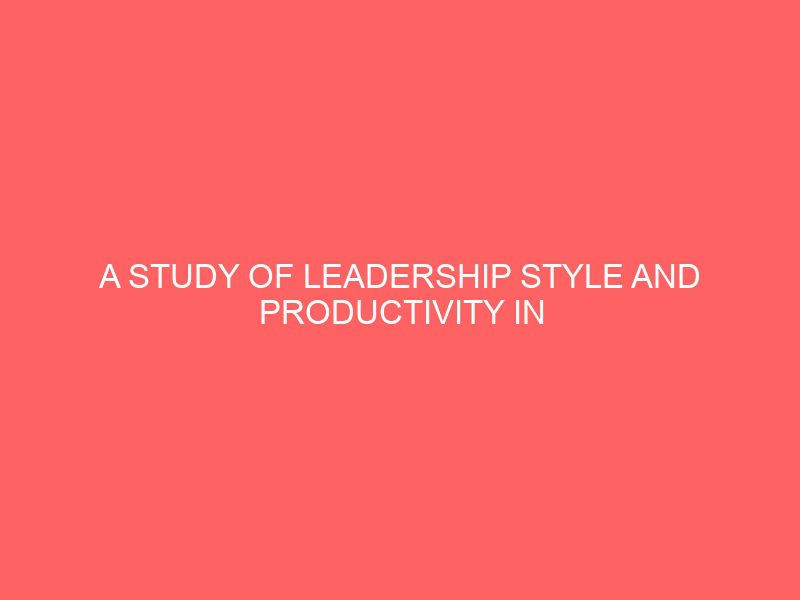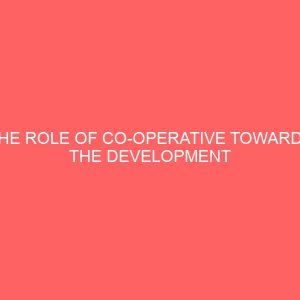Description
CHAPTER ONE INTRODUCTION 1.1 BACKGROUND OF STUDY If members of an organization are asked to choose their own leader, most people may choose one and the same person. If you study the over chosen person closely, you will most probably find that he is not merely popular in the superficial sense; he is a protagonist of the needs and desire of a large number of the population. He often acts on behalf of others with a sensitivity of response which does not exist in the average individual. Such people are often individuals who see beyond the narrow circumference of their own personal needs into the wider range of the needs of the fellow citizens. However, events may occur which may alter the prestige of particular individuals. The structure of the group may also change depending on the task which confronts it. This suggests that leadership is dynamic and situational. Leadership in organizations ought, therefore, to be democratized and decision making powers decentralized. A good leader is one who is most fitted to take charge in any given situation. However, in organizations, situations do not change so dramatically. The leader of a work team is the supervisor, foreman or manager, chairman or president as the case may be. But he should under no circumstance force himself on the group by virtue of his formal authority. This is the legitimacy question. An individual status is based on the degree to which he contributes to the achievement of the groups? goals and objectives. Administrative leadership exists in the context of an organization or public sector. It involves formal authority. Here, leaders, usually have institutional position, the status and authority of which become part of their roles. The mere recognition of legitimate authority disposes men to obey. Every formal organization therefore is characterized by hierarchy through which definition of roles, apportionment of responsibilities, gradation and institutionalization of position, accountability and communication are ensured. Intelligent direction on the part of the leader, coupled with devotion to work by the subordinates, given an organization its desired success of improving on staff productivity. Hence, administrative leadership in the public sector, like all forms of formal leadership requires legitimacy, for any leadership that does not enjoy the confidence and support of its followers is unlikely to succeed. Leadership is seen from various concepts; as its study began around 1900 and focus on traits that distinguish great leaders from the masses. Fielder asserted that apart from traits and behaviour, the nature of followers, job characteristics can influence leadership. It is agreed that leadership is a one-way or mutual process of influence that command obedience. Muson (1921), defined leadership as ?the ability to handle men so as to achieve the most with the least function and the greatest co-operation. Bennise (1959), on the other hand, saw leadership as the process by which an agent induces a subordinated to behave in a desired manner. Also, Wash (1929) suggested that ?leadership implies influencing change in the conduct of people. The new employees who are still lacking in sense of direction have a remarkable change in behaviour within a couple of days by the influence of the leaders (managers, chairmen, etc.). Tead (1935) defined leadership as the ?activity of influencing people to co-operate toward goals which they came to find desirable? Massarik (1961) defined leadership as ?interpersonal influence, exercised in a situation and directed, through the communication process toward the attainment of a specified goal or goals. In any given organization or sector, their goals. In any given organization or sector, their goals must not be in conflict of the individual employees goals and inspirations. In view of the foregoing, the researcher got motivated to investigated on how the style of leadership adopted can improve the productivity level of the staff in the Oke-Ogun Polytechnic, Saki. 1.2 STATEMENT OF PROBLEM Leadership and staff productivity in Nigeria Public sector had engaged the attention of many. They are of the view that productivity improvement in the public sector is dependent upon the leadership and leadership style. Leadership style in any organization affects negatively or positively the productivity of staff. Abah (1997) asserts that staff condition of service like salaries, tenure of office, Medicare, leaves, retirement, pension benefits, recognition, sense of inclusiveness and partial involvement in decision making if taken cognizance of by leadership, improves on productivity. Likert (1967), noted that leadership is a relative process in that for any leader to be successful (and likewise for any sector to produce effectively), he must recognize certain issues like expectations, values and interpersonal skills of those with whom he is interacting. The leader must exhibit behaviors and organizational processes that when perceived by followers, they will see them as supportive of their efforts and of their sense of personal worth. Leadership in this sense must be exercised in such a way as to further the task performance and personal welfare of followers. Leadership here must be for group cohesiveness and motivation for productivity improvement by providing freedom for responsible decision making and exercise of initiative. Hence in order to fill the above gap and problems, we pose the following questions. (1) What is the leadership style operational in The Oke-Ogun Polytechnic, Saki? (2) What is the level of the quality and quantity of services rendered by the leadership of The Oke-Ogun Polytechnic, Saki? (3) Is there need to adopt other motivating measures to improve on staff productivity level in The Oke-Ogun Polytechnic, Saki? (4) What are the impediments to staff productivity improvement in the Oke-Ogun Polytechnic, Saki? (5) What are the suggestions to be proferred in staff productivity improvement in The Oke-Ogun Polytechnic, Saki? 1.3 OBJECTIVE OF STUDY By mere looking at the metamorphosis of Nigerian public sector administration one may be tempted to arrive at the conclusion that there is high level of productivity by the staff. Therefore it is the objective of this work to: (1) To examine the leadership style prevalent in The Oke-Ogun Polytechnic, Saki (2) To identify the level of quality and quantity of services rendered by the leadership of The Oke-Ogun Polytechnic, Saki. (3) To find out the level of staff productivity in The Oke-Ogun Polytechnic, Saki. (4) To determine impediments to staff productivity in The Oke-Ogun Polytechnic, Saki. (5) To proffer suggestions towards improved productivity. 1.4 SIGNIFICANCE OF STUDY This academic work will help in the identification of those factors which constitute logs in the wheel and frustrate the raison d??tre in the staff productivity in Nigeria which necessitates the need to increase productivity level of staff in Nigerian public sector. More importantly, the fundamental basis of this study is channeled into two dimensions namely, theoretical and practical. Theoretically therefore, the study will add and contribute to the existing literature on leadership and its impact on staff productivity in the public sector, especially with regard to the need and expediency for increase productivity in keeping with the latest and current trends of grass root development. Besides, it will be of particular importance to authorities, administrators, lecturers, leaders and staff in the private and public sectors, captain of industries, researchers and students of public administration. On the practical aspect, the study will assist in drawing the attention of governments to the need of increase in productivity of staff in public sector. Finally, it will be a veritable source of reference for policy formulators within and outside the Public Sector area. 1.5 SCOPE AND LIMITATION OF THE STUDY The scope of this study was on leadership style and staff productivity improvement in the Nigerian Public Sector, which was limited to The Oke-Ogun Polytechnic, Saki .Some staff members in The Oke-Ogun Polytechnic, Saki were used for study to understand how the leadership style in practice affects their productivity and work improvement. Likewise, certain limitations were experienced in the course of writing this project, which caused it to take a longer time than expected. Limitations like home problem, finance, personal office work conflicting with the writing of the project which gave rise to lack of time. The researcher was short of time to co-ordinate home, office and project writing.







